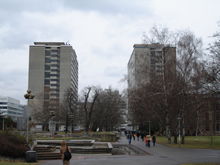University of Stuttgart
University of Stuttgart
| University of Stuttgart | |
|---|---|
| Universität Stuttgart | |
 |
|
| Established | 1829 |
| Type | Public |
| Rector | Univ.-Prof. Dr.-Ing. Wolfram Ressel |
| Admin. staff | 5,000 |
| Students | 22,632[1] |
| Location | Stuttgart, |
| Affiliations | PEGASUS |
| Website | www.uni-stuttgart.de/ |
The University of Stuttgart (German Universität Stuttgart) is a university located in Stuttgart, Germany. It was founded in 1829 and is organized in 10 faculties.
It is one of the top nine leading technical universities in Germany (TU9) with highly ranked programs in civil, mechanical, industrial and electrical engineering.
The University of Stuttgart is especially known for its excellent reputation in the fields of advanced automotive engineering, efficient industrial and automatical manufacturing, process engineering, aerospace technology and activity based costing. The academic tradition of the University of Stuttgart goes back to its probably most famous graduate student Gottlieb Daimler – the Inventor of the Automobile.
The University of Stuttgart, as well as Technical University of Munich, Technical University of Darmstadt and Karlsruhe Institute of Technology, represents one of the four members of the South German Axis of Advanced Engineering and Management. These four universities, in combination with RWTH Aachen are the top five universities of the before mentioned TU9.
Contents[hide] |
History
From 1770 to 1794, the Karlsschule was the first university in Stuttgart. Located in Stuttgart-Hohenheim, it has since 1818 been theUniversity of Hohenheim and is not related to the University of Stuttgart, except for some joint activities.
What is now the University of Stuttgart was founded in 1829, and celebrated its 175th anniversary in 2004. Because of the increasing importance of the technical sciences and instruction in these fields, from 1876 the university was known as the Technical College. In 1900 it was awarded the right to grant doctoral degrees in the technical disciplines. The development of the courses of study at the Technical College of Stuttgart led to its renaming in 1967 to the present-day “Universität Stuttgart”.
Since the end of the 1950s, a part of the university has been located in the suburb of Stuttgart-Vaihingen. Most technical subjects (computer science, engineering, etc.) are located in Vaihingen, while social sciences, architecture, and similar topics are still located in the city center campus.
Famous students
- Gunnar Birkerts Architect
- Dr. Wieland Backes German TV host of SWR Nachtcafé
- Gustav Bauernfeind German painter, illustrator and architect of Jewish origin
- Volker Beck
- Günter Behnisch Famous German Architect
- Gottlieb Daimler Germany’s most famous engineer: The Inventor of “The Automobile” and co-founder (together with Carl Benz) of Mercedes-Benz
- Dr. Siegfried Dais Member of the Board for IT of Bosch
- Dr. Volkmar Denner Member of the Board for Research and Advanced Engineering of Bosch
- Gerhard Ertl
- Max Eyth
- Gego
- Ernst Heinkel
- Rolf-Dieter Heuer
- Prof. Jürgen Hubbert a.k.a. “Mr. Mercedes” – Former Member of the Board of Daimler AG
- Wunibald Kamm
- Heinz-Hermann Koelle
- Berthold Leibinger
- Fritz Leonhardt
- Dr. h.c. Michael Macht Former CEO of Porsche AG
- Wilhelm Maybach Famous German engineer and automobile designer
- Ulf Merbold
- Frieder Nake
- Dr. Dirk Notheis CEO of Morgan Stanley Germany
- Wilfried Porth Member of the Board for HR of Daimler AG
- Karl Schlecht German Engineer – Inventor of the first automatical concrete rendering machine – Founder of Putzmeister AG
- Dr. Joachim Schmidt Senior Vice President Mercedes-Benz-Cars Sales and Marketing
- Dr. Hermann Scholl Former CEO of Bosch
- Matthias Seifert
- Horst Stormer
- Gerald Fredrick Töben
- Ulrich Walker Former CEO of Smart and CEO of Daimler North East Asia
- Dr. Jürgen Weber Former CEO of Lufthansa
- Dr. Thomas Weber Member of the Board for R&D of Daimler AG
- Dr. Martin Winterkorn CEO of Volkswagen AG
- Dr. Klaus Zehender Head of Procurement of Daimler AG
Organization
The university is divided into 10 faculties:
- Faculty of Architecture and Urban Planning
- Faculty of Civil– and Environmental Engineering
- Faculty of Chemistry
- Faculty of Geo– and Biosciences
- Faculty of Computer Science, Electrical Engineering and Information Technology
- Faculty of Aerospace Engineering and Geodesy
- Faculty of Mechanical Engineering
- Faculty of Mathematics and Physics
- Faculty of Humanities
- Faculty of Management, Economics and Social Sciences




